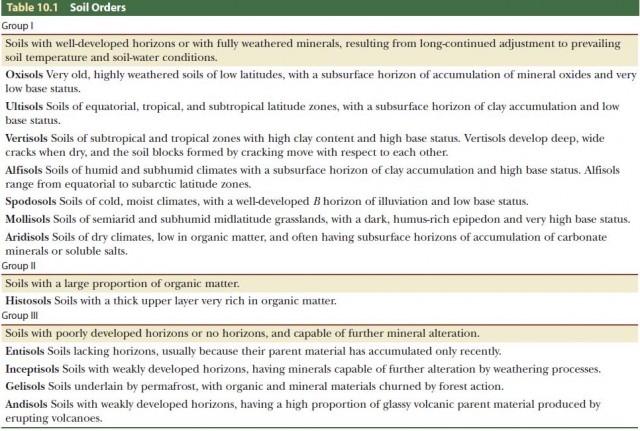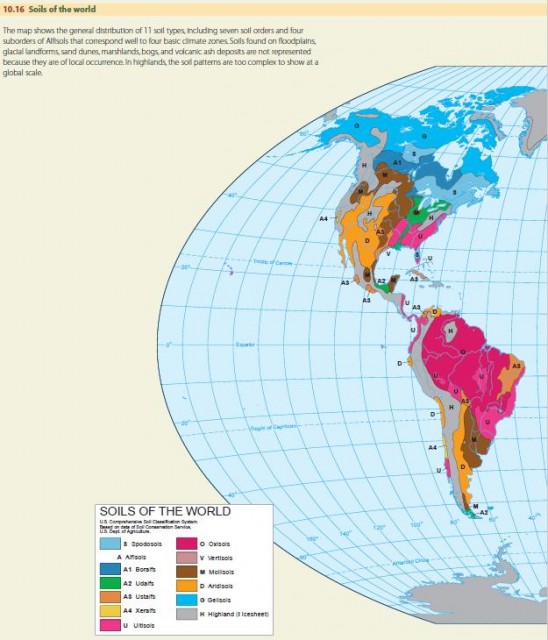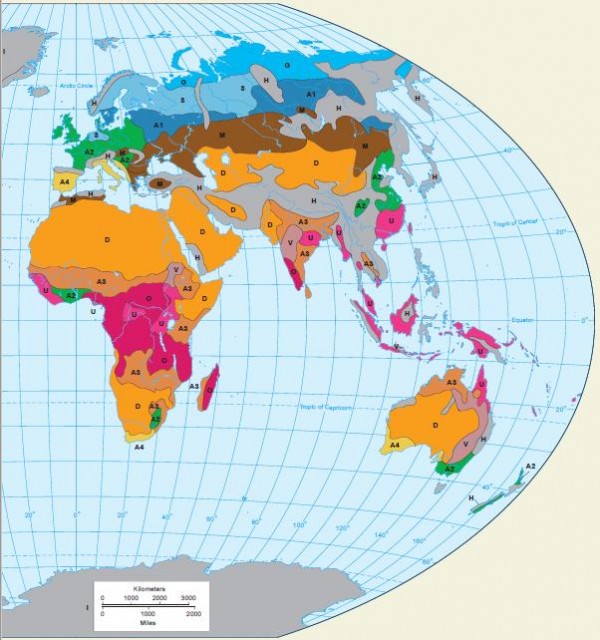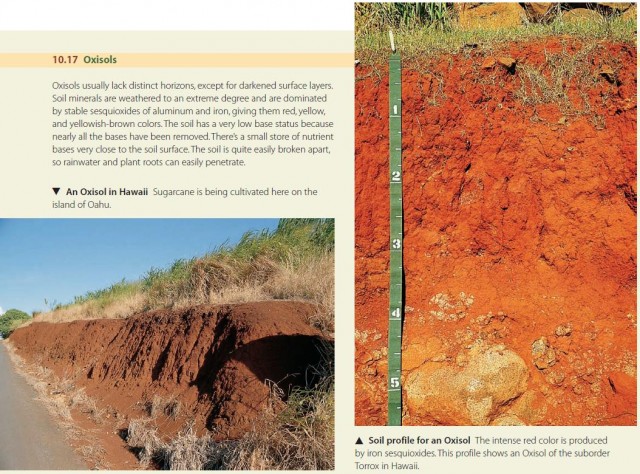The Global Scope of Soils
How soils are distributed around the world helps to determine the quality of environments of the globe. That's because soil fertility, along with the availability of fresh water, is a basic measure of the ability of an environmental region to produce food for human consumption.
We classify soils according to a system developed by scientists of the U.S. Natural Resources Conservation Service, in cooperation with soil scientists of many other nations. In this book, we'll discuss the two highest levels of this classification system. The top level contains 12 soil orders summarized in Table 10.1. We'll also mention a few important suborders that make up the second classification level.

There are three groups of soil orders, as shown in the table. The largest group includes seven orders with well-developed horizons or fully weathered minerals. A second group includes a single soil order that is very rich in organic matter. The last group includes four soil orders with poorly developed horizons or no horizons. Figure 10.16 is a map of world soil orders. Let's look at the soil orders in more detail.


OXISOLS, ULTISOLS, AND VERTISOLS
The low latitudes are dominated by three soil orders: Oxisols, Ultisols, and Vertisols. These soils have developed over long time spans in an environment with warm soil temperatures and plentiful soil water either in a wet season or throughout the year.
Oxisols have developed in the moist climates of the equatorial, tropical, and subtropical zones on land surfaces that have been stable over long periods of time. We find these soils over vast areas of South America and Africa in the wet equatorial climate 1 , where the native vegetation is rainforest. The wet-dry tropical climate in South America and Africa, with its large seasonal water surplus, is also associated with Oxisols. Figure 10.17 shows a soil profile for an Oxisol in Hawaii.

Ultisols are similar to the Oxisols, but have a subsurface clay horizon. They originate in closely related environments. In a few areas, the Ultisol profile contains a subsurface horizon of sesquioxides called laterite. This horizon can harden into brick-like blocks when it is exposed to the air.
We find Ultisols throughout Southeast Asia and the East Indies. Other important areas are in eastern Australia, Central America, South America, and the southeastern United States. Ultisols extend into the lower midlatitude zone in the United States, where they correspond quite closely with areas of moist subtropical climate. In lower latitudes, Ultisols are identified with the wet-dry tropical climate and the monsoon and trade-wind coastal climate. Note that all these climates have a dry season, even though it may be short.
Before the advent of modern agricultural technology, both Oxisols and Ultisols of low latitudes were cultivated for centuries using a primitive slash-and-burn agriculture. Without fertilizers, these soils can sustain crops on freshly cleared areas for only two or three years at most, before the nutrient bases are exhausted and the garden plot must be abandoned. For sustained high-crop yields, substantial amounts of lime and fertilizers are required. Ultisols are also vulnerable to devastating soil erosion, particularly on steep hill slopes.
Vertisols have a unique set of properties that stand in sharp contrast to the Oxisols and Ultisols. They are black in color and have a high clay content. The clay minerals are of a particular type that swells and shrinks with wetting and drying, producing deep cracks in the soil. Vertisols typically form under grass and savanna vegetation in subtropical and tropical climates with a pronounced dry season. These climates include the semiarid subtype of the dry tropical steppe climate and the wet-dry tropical climate.
Because Vertisols require a particular type of silicate mineral as a parent material, regions of this soil are scattered and show no distinctive pattern on the world map. An important region of Vertisols is the Deccan Plateau of western India, where basalt, a dark variety of igneous rock, supplies the silicate minerals that are altered into the necessary clay minerals.
ALFISOLS AND SPODOSOLS
The Alfisols are soils characterized by a clay-rich horizon produced by illuviation. The world distribution of Alfisols is extremely wide in latitude. Alfisols range from latitudes as high as 60° N in North America and Eurasia to the equatorial zone in South America and Africa. Obviously, the Alfisols span an enormous range in climate types. For this reason, we need to recognize four of the important suborders of Alfisols, each with its own climate affiliation.
Boralfs are Alfisols of cold (boreal) forest lands of North America and Eurasia. They have a gray surface horizon and a brownish subsoil. Udalfs are brownish Alfisols of the midlatitude zone. Ustalfs are brownish to reddish Alfisols of the warmer climates. Xeralfs are Alfisols of the Mediterranean climate, with its cool moist winter and dry summer. The Xeralfs are typically brownish or reddish in color.
Poleward of the Alfisols in North America and Eurasia lies a great belt of soils of the order Spodosols, formed in the cold boreal forest climate beneath a needleleaf forest. They are distinguished by a spodic horizon—a dense accumulation of iron and aluminum oxides and organic matter—and a gray or white albic E horizon that lies above the spodic horizon.
Spodosols are closely associated with regions recently covered by the great ice sheets of the Pleistocene Epoch. These soils are therefore very young. Typically, the parent material is coarse sand consisting largely of the mineral quartz. This mineral cannot weather to form clay minerals, so Spodosols are naturally poor soils in terms of agricultural productivity. Because they are acid, lime application is essential. They also need heavy applications of fertilizers. With proper management, Spodosols can be highly productive, if the soil texture is favorable—they give high yields of potatoes in Maine and New Brunswick.
HISTOSOLS
Throughout the northern regions of Spodosols are countless patches of Histosols. This unique soil order has a very high content of organic matter in a thick, dark upper layer. Most Histosols go by common names such as peats or mucks. They have formed in shallow lakes and ponds by accumulation of partially decayed plant matter. In time, the water is replaced by a layer of organic matter, or peat, and becomes a bog. Peat from bogs is dried and baled for sale as a mulch for use on suburban lawns and shrubbery beds. For centuries, Europe has used dried peat from bogs of glacial origin as a low-grade fuel.
Some Histosols are mucks—organic soils composed of fine black materials of sticky consistency. These are agriculturally valuable in midlatitudes, where they occur as beds of former lakes in glaciated regions. After appropriate drainage and application of lime and fertilizers, these mucks are remarkably productive for garden vegetables. Histosols are also found in low latitudes where poor drainage has favored thick accumulations of plant matter.
ENTISOLS, INCEPTISOLS, GELISOLS, AND ANDISOLS
Entisols are mineral soils without distinct horizons. They are soils in the sense that they support plants, but they may be found in any climate and under any vegetation. They don't have distinct horizons for two reasons: either the parent material, for example, quartz sand, is not appropriate for horizon formation; or not enough time has passed for horizons to form in recent deposits of alluvium or on actively eroding slopes. Inceptisols are soils with weakly developed horizons, usually because the soil is quite young. Entisols and Inceptisols can be found anywhere from equatorial to arctic latitude zones. Often they occur as patches too small to show on the global soils map.
Entisols and Inceptisols of floodplains and delta plains in warm and moist climates are among the most highly productive agricultural soils in the world because of their favorable texture, ample nutrient content, and large soil-water storage. In Southeast Asia, Inceptisols support dense populations of rice farmers.
Annual river floods cover low-lying plains and deposit layers of fine silt. This sediment is rich in primary minerals that yield bases as they weather chemically over time. The constant enrichment of the soil explains the high soil fertility in a region where uplands develop Ultisols with low fertility.
Gelisols are soils of cold regions that are underlain by permanently frozen ground, or permafrost. They usually consist of very recent parent material, left behind by glacial activity during the Ice Age, along with organic matter that decays only slowly at low temperatures. They are subjected to frequent freezing and thawing, which causes ice lenses and wedges to grow and melt in the soil. This action churns the soil, mixing parent material and organic matter irregularly and inhibiting development of a soil profile.
Andisols are soils in which more than half of the parent mineral matter is volcanic ash, spewed high into the air from the craters of active volcanoes and coming to rest in layers over the surrounding landscape. The fine ash particles are glass-like shards. Andisols have a high proportion of carbon, formed from decaying plant matter, so the soil is very dark. They form over a wide range of latitudes and climates and are generally fertile soils. In moist climates they support a dense natural vegetation cover.
Andisols aren't shown on our world map because they are found in small patches associated with individual volcanoes that are located mostly in the “Ring of Fire”—the chain of volcanic mountains and islands that surrounds the great Pacific Ocean. Andisols are also found on the island of Hawaii, where volcanoes are presently active.
MOLLISOLS
Mollisols are grassland soils that occupy vast areas of semiarid and subhumid climates in midlatitudes. They are unique in having a very thick, dark brown to black surface horizon called a mollic epipedon. Most areas of Mollisols are closely associated with the semiarid subtype of the dry midlatitude climate and the adjacent portion of the moist continental climate.
In North America, Mollisols dominate the Great Plains region, the Columbia Plateau, and the northern Great Basin. In South America, a large area of Mollisols covers the Pampa region of Argentina and Uruguay. In Eurasia, a great belt of Mollisols stretches from Romania eastward across the steppes of Russia, Siberia, and Mongolia. Because of their loose texture and very high base status, Mollisols are among the most naturally fertile soils in the world. They now produce most of the world's commercial grain crop. Most of these soils have been used for crop production only in the last century. Before that, they were used mainly for grazing by nomadic herds. The Mollisols have favorable properties for growing cereals in large-scale mechanized farming and are relatively easy to manage. Production of grain varies considerably from one year to the next because seasonal rainfall is highly variable.
A brief mention of four suborders of the Mollisols commonly found in the United States and Canada will help you to understand important regional soil differences related to climate. Borolls, the coldclimate suborder of the Mollisols, are found in a large area extending on both sides of the U.S.-Canadian border east of the Rocky Mountains as well as in Russia. Udolls are Mollisols of a relatively moist climate. They used to support tall-grass prairie, but today they are closely identified with the corn belt in the American Midwest, as well as the Pampa region of Argentina.
Ustolls are Mollisols of the semiarid subtype of the dry midlatitude climate, with a substantial soil-water shortage in the summer months. They underlie much of the short-grass prairie region east of the Rockies. Xerolls are Mollisols of the Mediterranean climate, with its tendency to cool, moist winters and rainless summers.
ARIDISOLS
Aridisols, soils of the desert climate, are dry for long periods of time. Because the climate supports only very sparse vegetation, the soils are low in organic matter. They are pale-colored, ranging from gray to red. They may have horizons with significant accumulations of calcium carbonate or soluble salts. The salts, mostly containing sodium, make the soil very alkaline. The Aridisols are closely correlated with the arid subtypes of the dry tropical, dry subtropical, and dry midlatitude climates. Most Aridisols are still used for nomadic grazing, just as they have been through the ages. With low and sporadic rainfall, it's difficult to cultivate crops. But with irrigation, Aridisols can be highly productive.